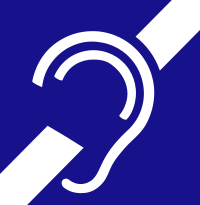
Photo from wikipedia
Objectives: Pediatric hearing impairment, regardless of degree and type, has a detrimental effect on speech perception, cognition, oral language development, academic outcomes, and literacy. Hearing assessment in the clinic is… Click to show full abstract
Objectives: Pediatric hearing impairment, regardless of degree and type, has a detrimental effect on speech perception, cognition, oral language development, academic outcomes, and literacy. Hearing assessment in the clinic is limited to 8 kHz although humans can hear up to 20 kHz. Hearing impairment in the extended high frequencies (EHFs > 8 kHz) can occur despite clinically normal hearing. However, to date, the nature and effects of EHF hearing impairment in children remain unknown. The goals of the present study were to determine the effects of EHF hearing impairment on speech-in-noise recognition in children and to examine whether hearing impairment in the EHFs is associated with altered cochlear functioning in the standard frequencies. Design: A volunteer sample of 542 participants (4 to 19 years) with clinically normal audiograms were tested. Participants identified with EHF impairment were assigned as cases in a subsequent case-control study. EHF loss was defined as hearing thresholds greater than 20 dB in at least one EHFs (10, 12.5, or 16 kHz). Speech recognition thresholds in multi-talker babble were measured using the digit triplet test. Distortion product otoacoustic emissions (f2 = 2, 3, 4, and 5 kHz) were measured to assess cochlear functioning. Results: Thresholds in the EHFs were as reliable as those in the standard frequency range. Thirty-eight children had EHF hearing impairment regardless of a clinically normal audiogram. A linear mixed-effects model revealed that children with EHF hearing impairment had higher (poorer) mean speech recognition threshold than children with normal EHF sensitivity (estimate = 2.14 dB, 95% CI: 1.36 to 3.92; effect size = small). The overall magnitude of distortion product otoacoustic emissions was lower for children with EHF impairment (estimate = –2.47 dB, 95% CI: –4.60 to –0.73; effect size = medium). In addition, the pure-tone average for standard audiometric frequencies was relatively higher for EHF-impaired children (estimate = 3.68 dB, 95% CI: 2.56 to 4.80; effect size = small). Conclusions: Hearing impairment in the EHFs is common in children despite clinically normal hearing and can occur without a history of otitis media. EHF impairment is associated with poorer speech-in-noise recognition and preclinical cochlear deficits in the lower frequencies where hearing thresholds are normal. This study highlights the clinical need to identify EHF impairments in children.
Journal Title: Ear and Hearing
Year Published: 2022
Link to full text (if available)
Share on Social Media: Sign Up to like & get
recommendations!